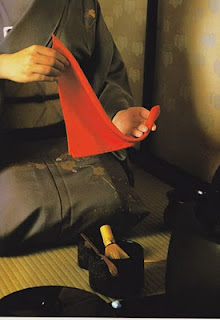I wrote earlier about the care and feeding of your fukusa, and as part two, I'd like to talk more about your fukusa.
During the preparation of tea, the fukusa is folded in various ways to purify utensils in front of the guests. I know of about 20 different ways to fold it. What you are doing is exposing different surfaces of the cloth to purify the different utensils. There are three categories of folds: shin (formal) gyo (semi-formal) and so (informal).
In the formal tea ceremony, koicha, one of the first movements is the formal inspection of the fukusa (yoho sabaki) before purifying the chaire. It is the clockwise movement used to examine the four sides of the fukusa. As with all parts of the temae there is additional meanings to the movements.
Inner aspects of the fukusa: Unlike usucha, koicha requires four meditative breathing pauses when folding the fukusa. This emphasizes the formality of koicha and the host and guest begin to breathe in unison. This is not to be hurried through. With each part of this movement there is a pause -- a breath and then movement, pause -- breath, movement until all four sides have been completed. The traditional meaning behind this action is the inner reflections that strengthen our character and is a directive for our lives. With daily examination of these inner aspects it will bring growth.
When the fukusa is open and in position centered over our left knee the first reflection is
Thoughtfulness "zin" Note here there is a pause but no breath
Then Righteousness "gi"
Thankfulness "rei"
Wisdom "chi"
Truth "shin"
Outer aspects of the fukusa: With the influx of modern life into the world of Chado, scholars have attempted to broaden the philosophy and understanding of Chado. Now reflections that are taught for this movement not only involve the inner aspects mentioned above, but also intertwine with more tangible ideas:
The first reflection is:
Heaven (above) note there is a pause but no breath
Parents (East)
Teachers (South)
Family (West)
Tea community (North)
The final movement is returning the fukusa to the center and forming a triangle with the thought of Earth (below). These concepts may be easier for the modern mind to accept because they are ideas we live with daily. These interpretations deal with the sharing aspect of tea rather than emphasis on inner progression. It is the blending of these two aspects the inner understanding and outward sharing that koicha is prepared and received.
2025 Puerh.uk TianMenShan Extra Tall Ancient
2 months ago

No comments:
Post a Comment